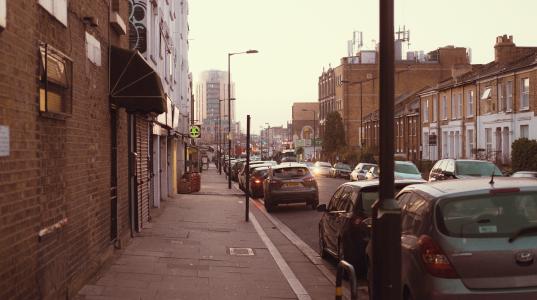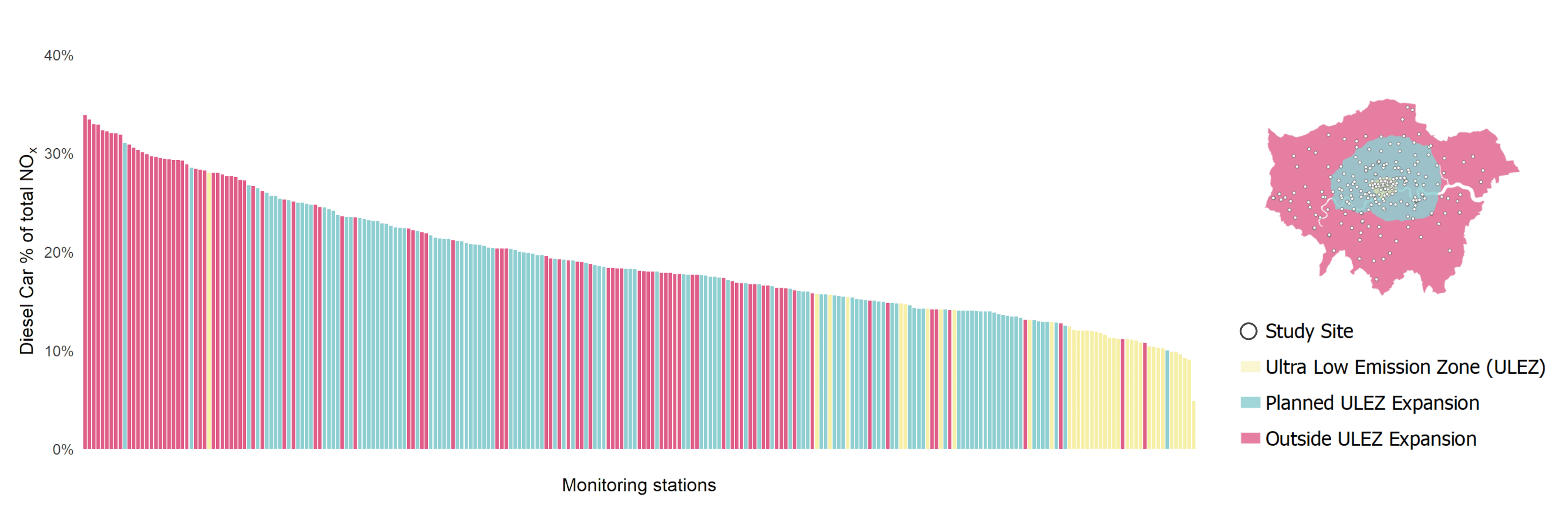
- Levels of NOx air pollution from diesel cars 23% higher at sites outside central London Ultra Low Emission Zone
- Sites with highest pollution contribution from diesel cars in areas excluded from expanded ULEZ
- Situation could worsen with increasing car ownership in Outer London
- Urgent call for more support to tackle diesel car pollution and to end sales sooner
A new analysis by Environmental Defense Fund Europe (EDF Europe) shows that air pollution created by diesel cars is higher at study locations in neighbourhoods outside the central London Ultra Low Emission Zone (ULEZ).
Based on modelled Breathe London data at 231 locations across the capital, the assessment reveals concentrations of toxic nitrogen oxides (NOx) gases from diesel cars are on average 23% higher at locations outside the ULEZ. In fact, the top five study sites most polluted by diesel cars are all outside the ULEZ:
- The Broadway, Southall
- Cromwell Road, Kingston
- Romford Road
- Putney High Street
- Euston Road
NOx pollution includes nitrogen dioxide (NO2), which can lead to adverse health impacts like inflaming airways and aggravating existing heart and lung diseases. Diesel engine exhausts have been classified as carcinogenic to humans.
The analysis also looks at sites where diesel cars contribute the most to NOx pollution, and found that those with the highest contributions were in areas that will be excluded from the expanded ULEZ. The ULEZ is the Mayor of London’s signature scheme to reduce emissions from diesel cars currently covering central London which will be expanded up to, but not including, the North and South Circular Roads in 2021.

It is alarming that one of the study locations with highest pollution concentrations and the greatest contribution from diesel cars is a site in Wembley in Brent, which is one of London’s most deprived neighbourhoods with poor respiratory health outcomes. The proportion of young people aged 10 to 18 requiring emergency admission for asthma is over 57% higher in Brent than in England as a whole.
The analysis also examines the number of cars in the capital. Car ownership in Outer London boroughs has been creeping up almost every year to reach its highest level in a decade. There are also more than 750,000 diesel cars still registered in the capital – 50% more than in 2010.
Today’s analysis raises a red flag to policymakers that a lack of action, especially in Outer London, may result in a car-led recovery that would likely increase toxic air pollution. Pollution may also worsen owing to more activity at local high streets, particularly as many office workers continue to work from home.
The Government has recently consulted on ending the sale of diesel cars, alongside petrol cars and vans by 2035. Environmental Defense Fund Europe joins the British Lung Foundation, Greenpeace UK, ClientEarth and Global Action Plan in urging the government to bring forward this date to 2030 so that we can breathe cleaner air sooner.
An end to diesel and petrol car sales must be undertaken equitably. A previous report by EDF Europe recommended that, as electric car sales increase, support should be targeted at or prioritised towards lower-income households. Examples include the Clean Vehicle Rebate Program in California, zero-interest loans in Scotland and London’s vehicle scrappage scheme in London.
Oliver Lord, Head of Policy and Campaigns at Environmental Defense Fund Europe said: “There is no hiding from the magnitude of pollution from diesel cars. Increasing car ownership and a lack of policy in Outer London could leave us in danger of dividing communities, and some of the most deprived neighbourhoods are at risk of being left behind in the fight for clean air. We need more ambition at a local level and for the Government to give us all the certainty that diesel has had its day, sooner rather than later.”
Professor Stephen Holgate, Royal College of Physicians Special Advisor on air quality and UKRI Clean Air Champion, University of Southampton said: “It is now time that the diesel scandal translates into real change to improve the air we all breathe. These data provide further evidence that we need incentives to remove diesel vehicles from our roads. The fact that even the new diesel vehicles pour out more ultra-fine particles than all other vehicles. Ultra-fines are the most toxic of the air pollution particles. The public needs incentives to change towards much less polluting vehicles.”
Katie Nield, Clean Air Lawyer at environmental law charity ClientEarth, said: “Diesel cars are the largest single culprit when it comes to illegal and harmful levels of nitrogen dioxide pollution. Not only should we be moving forward the phase out date for sales of these vehicles, but we also need to restrict their access in the most polluted parts of towns and cities now.
“London’s ULEZ has been effective at doing exactly that, which has led to lower pollution in the city centre. These new figures make it even clearer that in order to protect people from the toxic fumes that persist across the capital, the Mayor needs to commit to expanding the ULEZ to cover the whole of Greater London.
“This needs to happen alongside greater help and support for people and businesses to move to cleaner forms of transport – which is essential to stimulating a healthy and green recovery from the economic consequences of the pandemic.”
Zak Bond, Policy Officer at the British Lung Foundation, said: “Breathing in dirty air is bad for everyone’s health but can be particularly dangerous for those living with lung conditions. A spike in air pollution levels can lead to symptoms getting worse, flare-ups and even the risk of hospitalisation.
“Now, more than ever, we need to protect everyone’s lungs, so we must improve air quality urgently. It is clear that bringing forward the date for the end of the sale of petrol, diesel and hybrid cars and vans to 2030 is a vital step towards getting the most polluting vehicles off the road and thus improving the quality of life for people with a lung condition.
“Alongside this we urgently need to see the ULEZ expanded to protect more people in London, as well as the rapid introduction of strong Clean Air Zones in other cities, support for active and public transport across the country, and a government commitment to stronger air quality laws in line with the guidelines from the international health community.”
Notes to Editors
- Methodology: https://www.edf.org/sites/default/files/documents/EDF%20Europe%20diesel…
- The Breathe London modelled data is the first time local sources of air pollution (such as cars, taxis, HGVs, buses, buildings and aviation) have been displayed alongside current pollution measurements in a major city on a public platform. A new tool allows members of the public and campaign groups to see what triggers different forms of local pollution at www.breathelondon.org/map-sources.
- The Breathe London modelled data draws on the 2013 London Atmospheric Emissions Inventory (LAEI), which estimates NOx concentrations at a Londonwide level. Until now there has been very little analysis of specific locations modelled for the year 2019.
- NOx is produced when fossil fuels are burned and contains nitrogen dioxide (NO2), which can have serious health impacts in the short and long term. London has breached legal limits for NO2 since 2010.
- The top 10 sites most polluted by diesel cars are: 1) Ealing – Southall, The Broadway, 2) Kingston Upon Thames - Cromwell Road, 3) Newham - Romford Road, 4) Wandsworth - Putney High Street, 5) Camden - Euston Road, 6) Tower Hamlets - Commercial Street, 7) Greenwich - Nelson Road, 8) Merton - Morden Civic Centre 2, 9) Brent – Ikea, 10) Westminster - Marylebone Road
- The International Agency for Research on Cancer (IARC), which is part of the World Health Organization (WHO), classified diesel engine exhaust as carcinogenic to humans in 2012. https://www.iarc.fr/news-events/iarc-diesel-engine-exhaust-carcinogenic/
- The Brent monitor area is ranked in the most deprived 10% of areas in the UK in the Index of Multiple Deprivation (IMD). The IMD is the official measure of relative deprivation in England, and follows an established methodological framework in broadly defining deprivation to encompass a wide range of an individual’s living conditions.
- Car ownership variant of data supplied by Department of Transport (based on table VEH0203) – August 2020. Inner and Outer London boroughs as defined on page 563 of the London Plan https://www.london.gov.uk/sites/default/files/intend_to_publish_-_clean.pdf
- Public Health England Public Health Profiles by borough https://fingertips.phe.org.uk/search/asthma#page/0/gid/1/pat/46/par/E39000018/ati/165/are/E38000020/iid/93137/age/249/sex/4/cid/4/page-options/car-do-0_ovw-do-0
- EDF Europe report on the affordability of electric vehicles https://www.edf.org/sites/default/files/documents/EDFE%20EV%20electrification%20report%20Oct%202019%20FINAL.pdf